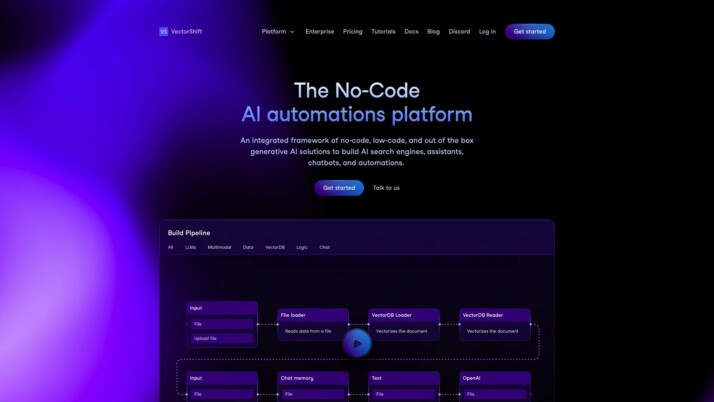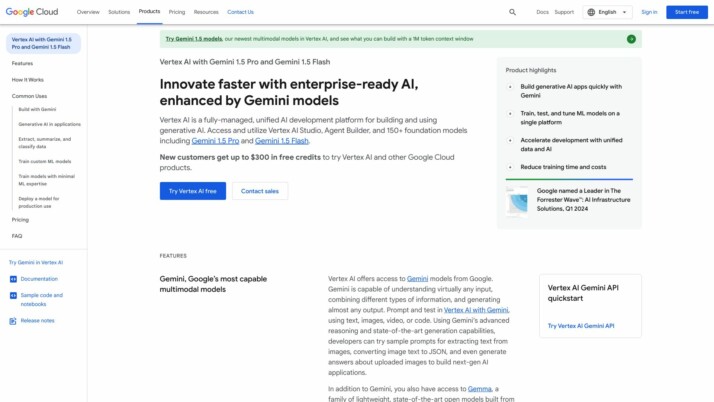In today’s rapidly evolving artificial intelligence landscape, the need for powerful yet accessible solutions to harness the potential of this transformative technology has never been greater. As we explore the capabilities of platforms like VectorShift vs. Vertex AI, and SmythOS, it is crucial to understand the unique strengths and use cases of each offering. This comprehensive review aims to provide valuable insights to help readers make informed decisions when selecting the most suitable AI platform for their specific needs.
VectorShift Overview
VectorShift is a comprehensive platform designed to empower users with the ability to create, deploy, and manage AI-driven workflows and automations. Their platform caters to both technical and non-technical audiences through its dual interface approach – a no-code builder and a code SDK. This versatility allows a diverse range of users to harness the power of AI for various applications.


VectorShift’s extensive automation capabilities stand out, allowing users to automate entire workflows, schedule tasks, and trigger actions based on predefined events. The platform seamlessly integrates with multiple data sources, enabling centralized data management and live-syncing across applications.
VectorShift excels in advanced content creation, allowing users to generate marketing copy, personalized emails, call summaries, proposals, and graphics at scale, all adhering to predefined formats and styles.
VectorShift’s pipeline dashboard streamlines the deployment process, where users can create AI workflows from scratch or leverage pre-built templates. The platform’s robust knowledge base centralizes data and performs semantic searches, enhancing the AI’s ability to provide accurate and relevant information.
Vertex AI Overview
Vertex AI is Google’s comprehensive machine learning platform designed to facilitate the development, deployment, and management of AI models and applications. It offers a unified toolset that integrates data engineering, data science, and machine learning workflows, enabling seamless collaboration among teams.


Vertex AI’s standout feature is Gemini, a multimodal generative AI model developed by Google DeepMind. Gemini supports prompts across various modes, making it suitable for diverse applications like chat assistants and on-demand content generation. It excels in advanced reasoning, multiturn chat interactions, code generation, and handling multimodal prompts.
Vertex AI’s Model Garden allows users to discover, test, customize, and deploy a wide range of generative AI models, including Google’s proprietary models and select open-source options.
Model customization tools enable users to fine-tune the behavior of Google’s foundation models, improving cost-efficiency and response latency. Features like grounding, retrieval-augmented generation (RAG), and function calling enhance model responses with real-time information and external API integration.
Vertex AI provides a comprehensive AI model management infrastructure, including a centralized model registry, a feature store for serving ML features efficiently, and MLOps integration for monitoring model performance and orchestrating workflows. The platform also offers specialized models for various applications and tasks.
Feature Comparison
VectorShift and Vertex AI differ significantly in their feature sets and capabilities. VectorShift is primarily focused on enabling users to create and deploy AI workflows and automations, while Vertex AI provides a more comprehensive machine learning platform tailored for enterprise-level deployments.
Vertex AI’s multimodal capabilities through its Gemini model stand out, supporting prompts across various modes like text, images, audio, video, and PDFs. This versatility allows for more diverse applications compared to VectorShift’s focus on text-based workflows. Vertex AI’s Model Garden also offers a wide range of generative AI models, with tools for customization and fine-tuning.
Vertex AI boasts robust features like separate development and production environments, constrained alignment for model control, explainability and transparency tools, and advanced debugging capabilities, catering to the needs of enterprises and large organizations.
In contrast, VectorShift’s platform appears more streamlined and user-friendly for rapid prototyping and deployment of AI workflows, with a visual builder and no-code approach.
| VectorShift | Vertex AI | SmythOS | |
|---|---|---|---|
| CORE FEATURES | |||
| No-Code | ✅ | ❌ | ✅ |
| Autonomous Agents | ❌ | ✅ | ✅ |
| Debug Tools | ❌ | ✅ | ✅ |
| Audit Logs for Analytics | ❌ | ✅ | ✅ |
| SECURITY | |||
| Data Encryption | ❌ | ✅ | ✅ |
| COMPONENTS | |||
| Classifiers | ❌ | ✅ | ✅ |
| Huggingface AIs | ❌ | ✅ | ✅ |
| Zapier APIs | ❌ | ✅ | ✅ |
| DEPLOYMENT OPTIONS | |||
| Staging Domains | ❌ | ✅ | ✅ |
| Production Domains | ❌ | ✅ | ✅ |
| Deploy as GPT | ❌ | ✅ | ✅ |
| DATA LAKE SUPPORT | |||
| Sitemap Crawler | ❌ | ✅ | ✅ |
| YouTube Transcript Crawler | ✅ | ❌ | ✅ |
Best Alternative to VectorShift and Vertex AI
While both VectorShift and Vertex AI offer innovative capabilities in the AI and machine learning space, SmythOS emerges as the superior alternative for a wide range of users and applications. SmythOS stands out with its user-friendly drag-and-drop interface and no-code editor, making advanced AI functionalities accessible to non-technical users and democratizing AI development.
SmythOS bridges the gap between ease of use and advanced functionality, making it the best alternative for users seeking to harness the full potential of AI across a wide range of applications.
At the same time, SmythOS provides robust features that cater to technical teams, including debugging tools, constrained alignment for model control, and support for autonomous agents. Its extensive integration ecosystem, with pre-built connectors for APIs like Zapier, Hugging Face models, and data sources like YouTube transcripts, empowers users to create sophisticated AI workflows without extensive coding.
Moreover, SmythOS excels in deployment flexibility, allowing agents to be deployed as APIs, webhooks, chatbots, or integrated with platforms like ChatGPT. This versatility ensures seamless integration into existing systems and workflows. With its scalability, data encryption, and OAuth security features, SmythOS meets the demands of enterprises and organizations, ensuring secure and reliable AI implementations.
While VectorShift and Vertex AI offer valuable capabilities in their respective domains, SmythOS emerges as the comprehensive solution that bridges the gap between ease of use and advanced functionality, making it the best alternative for users seeking to harness the full potential of AI across a wide range of applications.
Conclusion
The AI landscape is rapidly evolving, and platforms like VectorShift, Vertex AI, and SmythOS are at the forefront of this revolution, each offering unique capabilities and features tailored to different user groups. VectorShift provides a comprehensive platform for creating and deploying AI workflows with its no-code builder and extensive automation capabilities, while Vertex AI stands out with its powerful Gemini model supporting multimodal prompts and advanced AI model management tools.
For users seeking a truly versatile and accessible solution, SmythOS emerges as the superior alternative. With its intuitive drag-and-drop interface and no-code editor, SmythOS democratizes AI development, making it accessible to both technical and non-technical users alike. Its extensive integration ecosystem, support for multi-agent orchestration, and secure deployment options across various platforms, including APIs, chatbots, and even ChatGPT plugins, set it apart from the competition.
Whether you’re a developer seeking to create sophisticated AI agents, a business professional looking to automate workflows, or a researcher exploring cutting-edge AI applications, SmythOS offers a comprehensive and user-friendly platform to harness the full potential of AI. With its scalability, data encryption, and OAuth security features, SmythOS is well-equipped to meet the demands of enterprises and organizations, ensuring secure and reliable AI implementations.
To learn more about how SmythOS can revolutionize your workflow and empower you with advanced AI capabilities, explore our agent templates or schedule a demo today.
Last updated:
Disclaimer: The information presented in this article is for general informational purposes only and is provided as is. While we strive to keep the content up-to-date and accurate, we make no representations or warranties of any kind, express or implied, about the completeness, accuracy, reliability, suitability, or availability of the information contained in this article.
Any reliance you place on such information is strictly at your own risk. We reserve the right to make additions, deletions, or modifications to the contents of this article at any time without prior notice.
In no event will we be liable for any loss or damage including without limitation, indirect or consequential loss or damage, or any loss or damage whatsoever arising from loss of data, profits, or any other loss not specified herein arising out of, or in connection with, the use of this article.
Despite our best efforts, this article may contain oversights, errors, or omissions. If you notice any inaccuracies or have concerns about the content, please report them through our content feedback form. Your input helps us maintain the quality and reliability of our information.
Alexander De Ridder
Co-Founder, Visionary, and CTO at SmythOS. Alexander crafts AI tools and solutions for enterprises and the web. He is a smart creative, a builder of amazing things. He loves to study “how” and “why” humans and AI make decisions.
Explore All Comparison Articles
Decisions vs. Sola: AI Workflow Automation Showdown
AI-powered workflow automation platforms revolutionize how businesses streamline operations and boost productivity. This comparison explores Decisions vs. Sola, and SmythOS,…
DeepOpinion vs. Sola: Comparing AI Automation Platforms
AI-powered automation platforms revolutionize business operations, but choosing the right solution can be challenging. This comparison of DeepOpinion vs. Sola,…
DevGPT vs. Sola: AI-Powered Development Tools Compared
AI-powered development tools revolutionize software creation, offering unprecedented efficiency and capabilities. This comprehensive review compares DevGPT vs. Sola, and SmythOS,…
Fine AI vs. Sola: Comparing AI Automation Tools
AI-powered automation transforms software development and business workflows, offering unprecedented efficiency and innovation. Fine AI vs. Sola present distinct approaches…
FlowiseAI vs. Sola: Comparing AI Automation Platforms
AI-powered automation revolutionizes business operations, driving efficiency and innovation across industries. FlowiseAI vs. Sola offer distinct approaches to harness this…
Gooey AI vs. Sola: AI-Powered Automation Platforms Compared
AI-powered automation platforms revolutionize how businesses streamline operations and enhance productivity. This comparison delves into Gooey AI vs. Sola, two…

